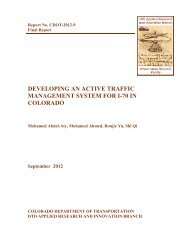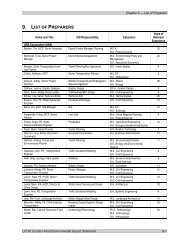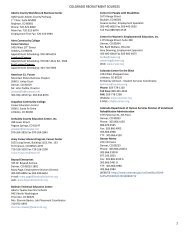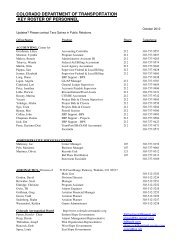Chapter 5 THE AUTOMOBILE AGE BEGINS, 1890-1930 - Colorado ...
Chapter 5 THE AUTOMOBILE AGE BEGINS, 1890-1930 - Colorado ...
Chapter 5 THE AUTOMOBILE AGE BEGINS, 1890-1930 - Colorado ...
Create successful ePaper yourself
Turn your PDF publications into a flip-book with our unique Google optimized e-Paper software.
In 1917, the State Legislature passed the Highway Act creating a State Highway Fund to<br />
distribute state and federal funds for the development and maintenance of the State Highway<br />
system. Lawmakers also reorganized the State Highway Commission into the State Highway<br />
Department. A commissioner and a five-man advisory board were responsible for the new<br />
department’s policies (Wiley, 1976: 15).<br />
The same year of the Federal Highways Act, the federal government established Rocky<br />
Mountain National Park near Estes Park. Located near Denver, the park is unique among the<br />
National Park System due to its proximity to a major urban center. Within three years of its<br />
creation – 1919 – Rocky Mountain Park drew almost 170,000 visitors. The mountain drive still<br />
was primitive as a motor guide from the early 1920s advised drivers to “use extreme caution” to<br />
“blow the horn at every turn” and never exceeds 12 miles per hour (Noel, 1987: 46). According<br />
to the National Park Service, the Rocky Mountain National Park was the leading tourist<br />
destination in the national system by the start of the 1920s (Thomas, 1996: 89).<br />
At the first meeting of the Highway Advisory Board of December 6, 1917, the board approved<br />
the first direct contracts let by the State Highway Department. <strong>Colorado</strong> and the federal<br />
government split the costs on six initial projects:<br />
Federal Aid Project (FAP)-1 Denver-Littleton (Santa Fe) $73,939.74<br />
FAP-2 Pueblo-Trinidad $267,191.91<br />
FAP-3 Granite-Twin Lakes $37,089.90<br />
FAP-4 Rifle-Meeker $79,082.85<br />
FAP-5 Placerville-Norwood $7,480.00<br />
FAP-6 Lamar to Springfield $10,030.90<br />
Supported by FAP money, in 1918, the Highway Department laid its first stretch of concrete<br />
pavement south of Denver along today’s Santa Fe Drive (U.S. Highway 85). Taking nearly a<br />
year, contractor Charles Connor of Denver poured a four-mile long, 16-foot-wide strip of<br />
concrete from Denver to Littleton at a cost of $77,571. Traffic volume supported the wisdom to<br />
concrete this section first. By 1923, the state counted 1,200 to 3,500 vehicles a day between<br />
Denver and <strong>Colorado</strong> Springs. That year, the Highway Department widened the road to 18 feet<br />
to accommodate increased volume (Maloney, 1924: 8-9). During the early 1920s, Santa Fe<br />
Final<br />
CDOT Historic Highway Context<br />
5-23









